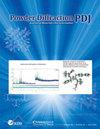盐酸贝西沙星C19H22ClFN3O3Cl的晶体结构
IF 0.4
4区 材料科学
Q4 MATERIALS SCIENCE, CHARACTERIZATION & TESTING
引用次数: 0
摘要
利用同步加速器x射线粉末衍射数据对盐酸贝西沙星的晶体结构进行了解析和细化,并利用密度泛函理论技术对其进行了优化。盐酸贝西沙星在P1(#1)空间群中结晶,a = 5.36596(8), b = 10.3234(4), c = 17.9673(14) Å, α = 98.122(5), β = 92.9395(9), γ = 96.1135(3)°,V = 977.483(13) Å3, Z = 2。晶体结构近似中心对称。强N-H, Cl氢键沿a轴形成波纹状阶梯状链。每个独立阳离子中的羧酸基团在与相邻羰基的强分子内O - h⋯O氢键中充当供体。粉末图案已提交给ICDD,纳入粉末衍射文件™(PDF®)。本文章由计算机程序翻译,如有差异,请以英文原文为准。
Crystal structure of besifloxacin hydrochloride, C19H22ClFN3O3Cl
The crystal structure of besifloxacin hydrochloride has been solved and refined using synchrotron X-ray powder diffraction data, and optimized using density functional theory techniques. Besifloxacin hydrochloride crystallizes in space group P1 (#1) with a = 5.36596(8), b = 10.3234(4), c = 17.9673(14) Å, α = 98.122(5), β = 92.9395(9), γ = 96.1135(3)°, V = 977.483(13) Å3, and Z = 2. The crystal structure is approximately centrosymmetric. Strong N–H⋯Cl hydrogen bonds form a corrugated ladder-like chain along the a-axis. The carboxylic acid group in each independent cation acts as the donor in a strong intramolecular O–H⋯O hydrogen bond to an adjacent carbonyl group. The powder pattern has been submitted to ICDD for inclusion in the Powder Diffraction File™ (PDF®).
求助全文
通过发布文献求助,成功后即可免费获取论文全文。
去求助
来源期刊

Powder Diffraction
工程技术-材料科学:表征与测试
CiteScore
0.90
自引率
0.00%
发文量
50
审稿时长
>12 weeks
期刊介绍:
Powder Diffraction is a quarterly journal publishing articles, both experimental and theoretical, on the use of powder diffraction and related techniques for the characterization of crystalline materials. It is published by Cambridge University Press (CUP) for the International Centre for Diffraction Data (ICDD).
 求助内容:
求助内容: 应助结果提醒方式:
应助结果提醒方式:


